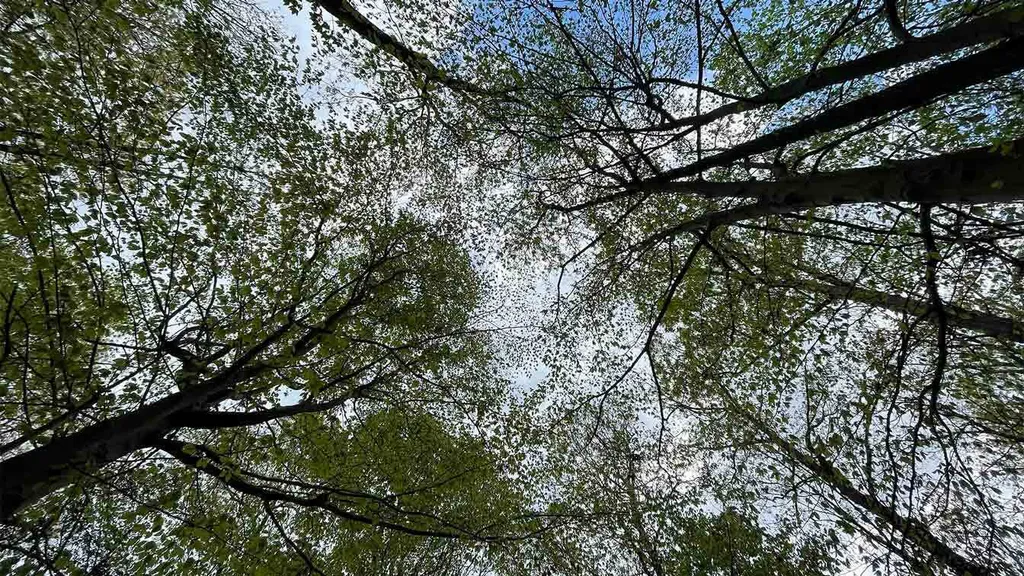- May 05, 2022
- By Kelly Blake
It’s a typically stressful workday careening toward the semester’s end, and I am spending part of it sprawled on my belly in the woods, watching skittering ants and little white mushrooms growing on decaying sticks.
I’m participating in a “forest bathing” session organized by Master of Public Health (MPH) students and faculty in the University of Maryland Department of Kinesiology as part of a course on creating and evaluating physical activity interventions taught by Associate Clinical Professor Brit Saksvig. In my role leading communications for the School of Public Health, I welcomed the invitation to explore this unconventional way of helping people manage stress, disconnect from technology and tune into the language of the forest.
Heidi Schreiber-Pan, a psychotherapist and author who directs the Towson-based Center for Nature Informed Therapy, leads about 15 undergrads, graduate students, faculty and staff April 27 to a patch of woods that I didn’t realize existed, even though I’ve been working just a quarter-mile from it for 10 years. We walk across a footbridge and up past the Terrapin Trail Garage to the Hillock trailhead, then fill out a survey that MPH students created to collect data gauging our mood, energy level and relationship to nature before and after the experience.
My survey responses are a downer: I report that I am feeling extremely jittery, moderately irritable and not very alert; the list of emotions also includes positive feelings like enthusiastic, proud and inspired. I check “strongly agree” that my relationship to nature is an important part of who I am. Schreiber-Pan, outfitted in hiking boots and a big pack that suggests a longer trek than what I anticipated, instructs that when we walk through the threshold of the trail to leave our to-do lists and worries behind.
The concept of forest bathing comes from the therapeutic Japanese practice of shinrin-yoku, based in the art and science of how trees can promote health and happiness. In 1982, the Japanese government sanctioned the practice as part of a national public health effort to alleviate stress and lower blood pressure, among other benefits. Today, there are groups around the world that train and certify people to act as “forest therapy guides,” yet Schreiber-Pan says that this process is expensive and unnecessary. Her center trains mental health professionals in “nature-informed” mental health practices; anyone who wants to guide people in a mindful forest experience, including UMD students, could be trained in three days.
Schrieber-Pan reminds us as we settle into a circle on a hill that for most of human history, we’ve been largely outdoors. Only in recent centuries have we spent the majority of our time inside, disconnected from the peace of the trees, plants and animals that are often just steps from our homes, classrooms and workplaces.
I am beginning to appreciate this rare middle-of-the-workday opportunity to slow down. As we continue to emerge from the pandemic in the context of overlapping and urgent global challenges and tragedies, more people than ever are dealing with mental health challenges. According to the National Institute for Mental Health, young adults ages 18-25 have the highest prevalence of mental illness, with anxiety disorders being the most common.
“Due to its stress-relieving qualities, forest therapy is ideal for any age group that encounters a high level of mental health challenges,” Schrieber-Pan says. “Anxiety results in an overactivation of the nervous system—just the thing that forest therapy addresses.”
She asks us to share a one-word answer to the question, “What does nature mean to you?” The answers reinforce the notion of finding healing and release: Freedom. Tranquility. Home. Spirit. Play.

After taking a few deep breaths together, Schrieber-Pan invites us to consider what we hear, smell, see and feel. While the wind rushes through the trees and insects scurry about with purpose, the pace is different here. “It isn’t like the ants are rushing from morning to night,” she says. “They slow down and they stop, unlike us.”
She invites us to lay on the earth, first on our stomachs, then on our backs. I feel energized by the green sprouts emerging from dead leaves and imagine this must be how the forest floor looks to a fox or rabbit. I think about how the trees in the canopy over me are connected, and perhaps talking to each other or observing us in return. My breathing finally slows.
Near the end of the session, the MPH students distribute a tea made from pine needles and honey; it is surprisingly good. Schreiber-Pan asks us to decide in small groups how we will show gratitude to the forest. AbryAnna Henderson, an undergraduate kinesiology student, suggests we hug some trees, and I enthusiastically agree.
“I have a lot of favorite trees and plants on campus that I like to look at, so this isn’t really new for me,” she says as we emerge from the woods. “But I think it was interesting to do it in a group setting and hear the perspectives of other people.”
Together, we fill out our exit survey. The MPH students later inform me that 38% of the participants reported feeling a high or overwhelming degree of stress before the session, but all reported low or no stress afterward.
“We think offering something like forest bathing (forest therapy, forest walks, etc.) on a more regular basis would be very beneficial to the UMD community,” says Jailyn Morris, an MPH student concentrating in physical activity. “From the things we heard participants say, it helped to calm a lot of people down, take away some stress and made them feel more connected to nature.”
Interested in forest therapy or other modes of finding calm and well-being through nature? Find out how on the NatureRx@UMD Laboratory’s website.
Topics
Campus & CommunityUnits
School of Public Health